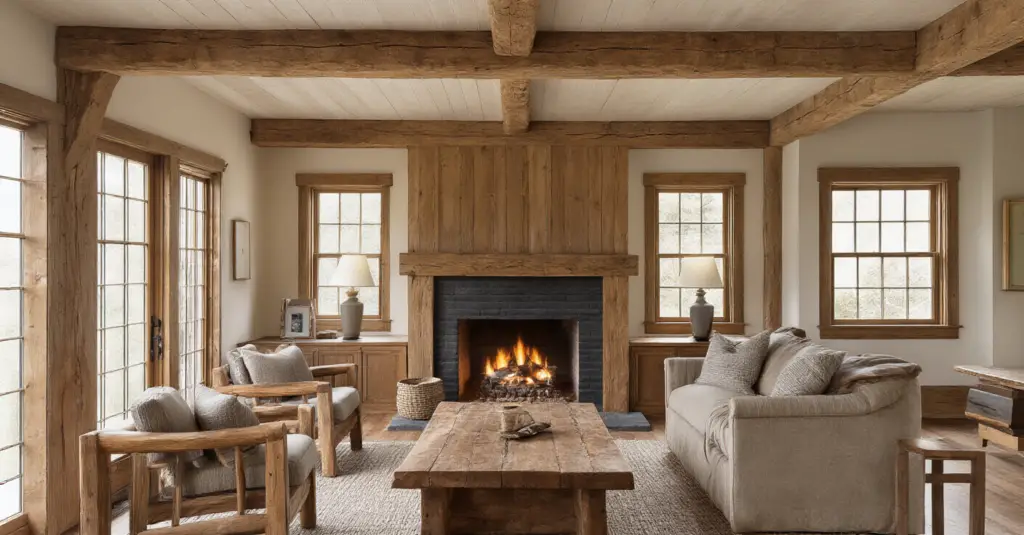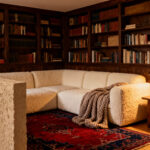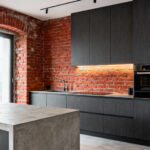Can we talk about why so many people get “rustic” wrong? It drives me nuts. They think it’s just about buying a leather couch, throwing a plaid blanket on it, and maybe hanging some fake antlers on the wall. They end up with a room that feels like a theme-park version of a log cabin—cluttered, generic, and totally missing the point.
The real magic of rustic design isn’t about collecting props. It’s about building a system. A system where every single element, from the floorboards to the lightbulbs, works together to create a feeling of genuine comfort, history, and connection to nature. It’s not about hiding clutter; it’s about creating intentional, beautiful storage and spaces that make your daily life easier and more peaceful. Forget the corporate speak and the catalog looks. Here’s how you actually build a rustic living room that feels like a real, soulful home.
Laying the Rustic Foundation: Essential Structural and Color Choices (Part 1)
Alright, first things first. Before you even think about buying a sofa or a coffee table, we have to build the box. A truly great design is built on a solid foundation. These aren’t just decorative choices; these are the structural and atmospheric rules that will govern every other decision you make. Get this part right, and the rest becomes infinitely easier.
1. Embrace Natural Wood Finishes for Architectural Charm
Look, the soul of any rustic design is wood. But I’m not talking about that cheap, plasticky laminate stuff that peels at the corners. I mean real, honest-to-goodness wood with grain, knots, and character. It’s the single most effective way to inject immediate warmth and history into a space. This isn’t just an accent; it’s part of the room’s architecture. Think wall paneling, a substantial fireplace mantel, or chunky window and door frames.
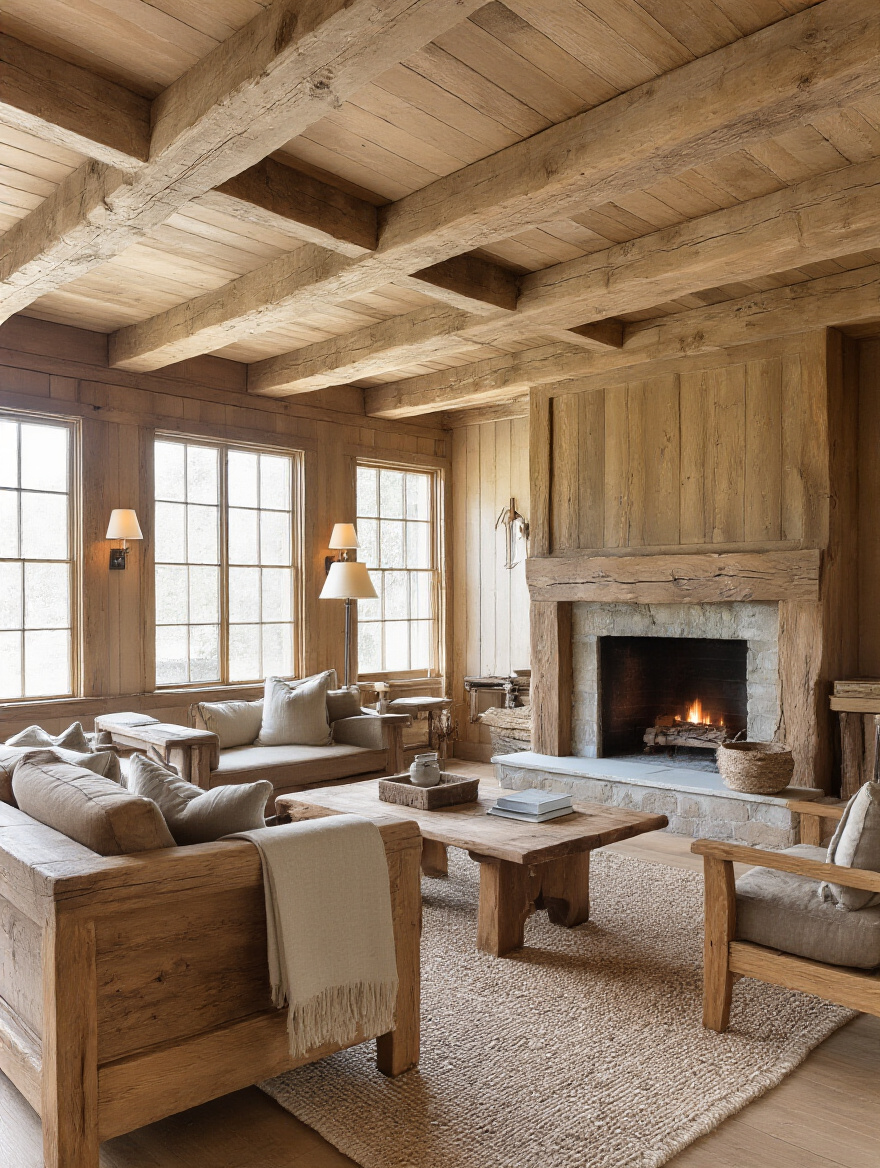
A client of mine once spent a fortune on rustic furniture, but the room felt sterile. Why? Because the “box” was just plain, boring drywall. We added reclaimed barn wood to one accent wall, and boom. The entire space instantly felt grounded and authentic. Don’t just decorate with wood; build the warmth directly into the structure of the room itself. It’s the difference between a costume and a real personality.
Now that you’ve got the warmth of wood setting the tone, we need to choose the colors that will support it, not fight against it.
2. Select a Warm, Earth-Toned Color Palette for Walls and Furniture
People constantly make the mistake of picking a stark, gallery-white for their walls, thinking it will make their rustic pieces “pop.” It doesn’t. It just creates a jarring contrast that feels cold and clinical. Your walls are the backdrop, and in a rustic system, that backdrop needs to feel like it came from nature. We’re talking about creams, warm taupes, muted sage greens, and soft terracotta.
Think of it like this: your wooden furniture, your stone fireplace—those are the main characters. The wall color is the supporting cast. Its job is to make the stars look good without stealing the show. Stick to colors you’d find on a walk in the woods. A warm, earthy palette allows all the other natural textures in the room to blend seamlessly, creating a cohesive and calming environment instead of a collection of disconnected objects.
With the right color on the walls, it’s time to draw the eye upward and add some serious architectural punch.
3. Incorporate Exposed Beams or Faux Wood Accents for Overhead Interest
An empty, flat white ceiling is a massive missed opportunity in a rustic room. Adding exposed beams, whether they’re actual structural supports or lightweight faux beams, instantly gives the room a sense of history and scale. It draws the eye up, making the space feel grander and more established, like it’s been there for a hundred years.
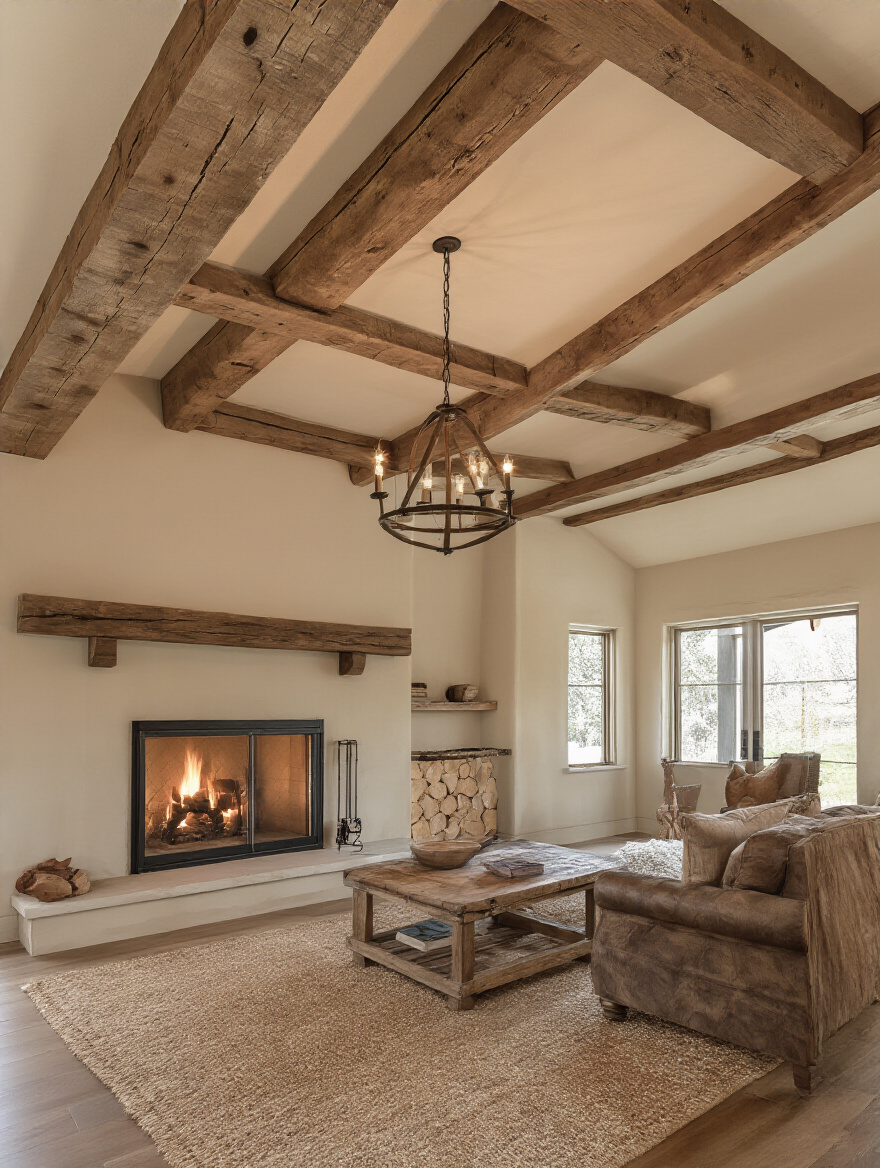
This is a classic custom cabinetmaker’s trick: use vertical and horizontal lines to define a space. Beams add that crucial overhead structure. And don’t dismiss the faux options! The good ones today are incredibly convincing and won’t require you to re-engineer your entire house. The goal is to add that textural, handcrafted layer that says, “this space was built with intention.”
Once the walls and ceiling are sorted, the last piece of our foundation is literally what’s under your feet.
4. Choose Hardwood or Stone Flooring Options for Authentic Appeal
Please, for the love of all that is organized and beautiful, step away from the gray vinyl plank. It’s the kryptonite of rustic design. To get that truly grounded, authentic feel, you need a floor made from natural materials like hardwood or stone. These materials have a weight and permanence that man-made stuff just can’t replicate. The subtle imperfections—the scuffs in a wide-plank pine floor or the texture of natural slate—are what give a room its soul.

This is the base layer of your entire system. A solid, natural floor anchors everything. It’s also incredibly practical. A good hardwood floor doesn’t just get old; it develops a patina. It tells the story of your life. It’s a long-term investment that provides a tactile and visual warmth that you’ll appreciate every single day.
Laying the Rustic Foundation: Essential Structural and Color Choices (Part 2)
Okay, our “box” is built. The walls, ceiling, and floor are speaking the right language. Now it’s time to bring in the main architectural elements that will define how you actually live in the space. These are the big, immovable pieces that the rest of your life will revolve around.
5. Prioritize an Oversized, Comfortable Sofa as the Room’s Centerpiece
This is non-negotiable. In a rustic living room, the sofa isn’t just a piece of furniture; it’s the heart of the home. It’s the command center for comfort. Go big, go deep, and go plush. This is where you signal that this room is for real living—for curling up with a book, for family movie nights, for long conversations. A wimpy, undersized sofa will make the entire room feel temporary and uninviting.
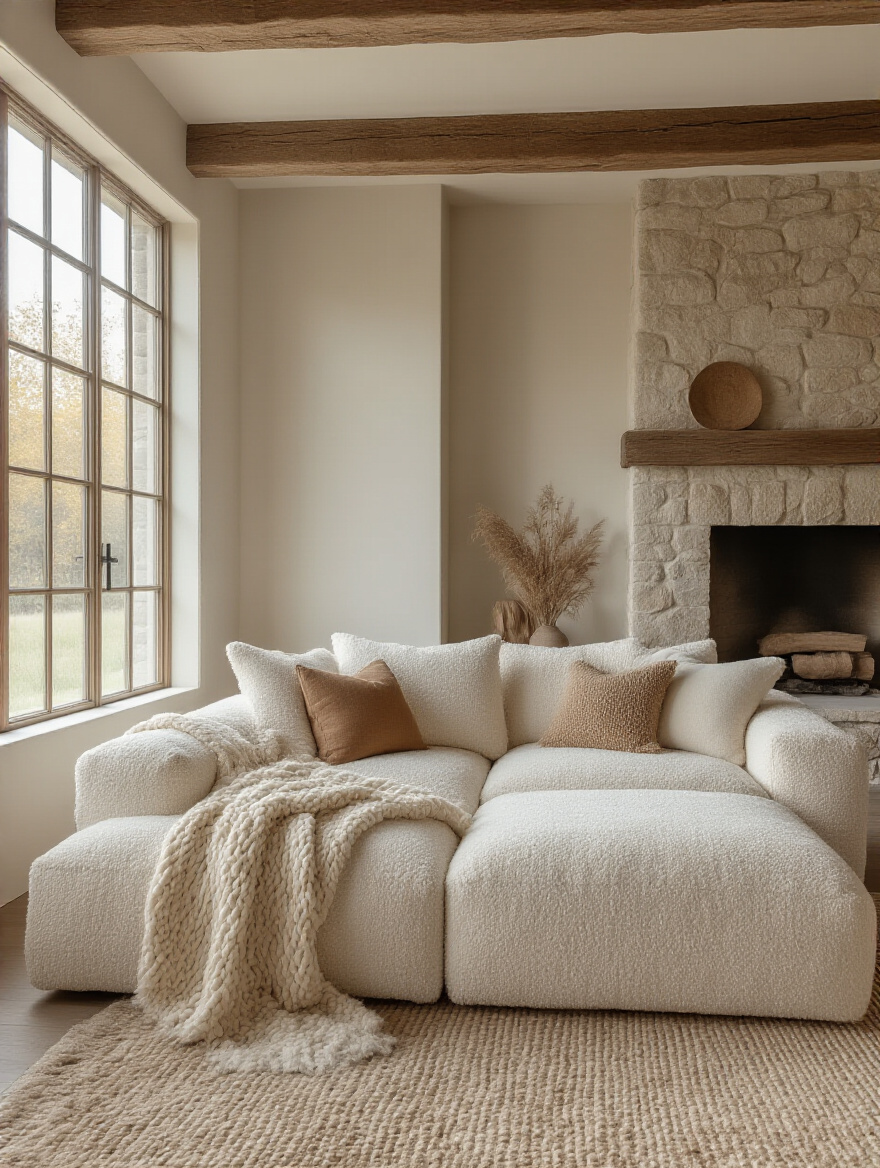
Think of the sofa as the primary anchor for your seating arrangement. Its substantial size will ground the space and make arranging other pieces around it a breeze. Opt for durable, textural fabrics like distressed leather that gets better with age, or a chunky, nubby linen in a warm neutral. This single piece sets the comfort level for the entire room. Don’t skimp on it.
With the hub of comfort established, we turn to the hub of warmth—the element that has gathered people for centuries.
6. Utilize Natural Stone or Reclaimed Brick for a Statement Fireplace Surround
If your sofa is the heart of the room, the fireplace is its soul. A dinky little insert surrounded by tile just won’t cut it. This is your chance to make a powerful architectural statement. A floor-to-ceiling surround made of natural fieldstone, river rock, or character-rich reclaimed brick gives the room an undeniable sense of permanence and gravity.
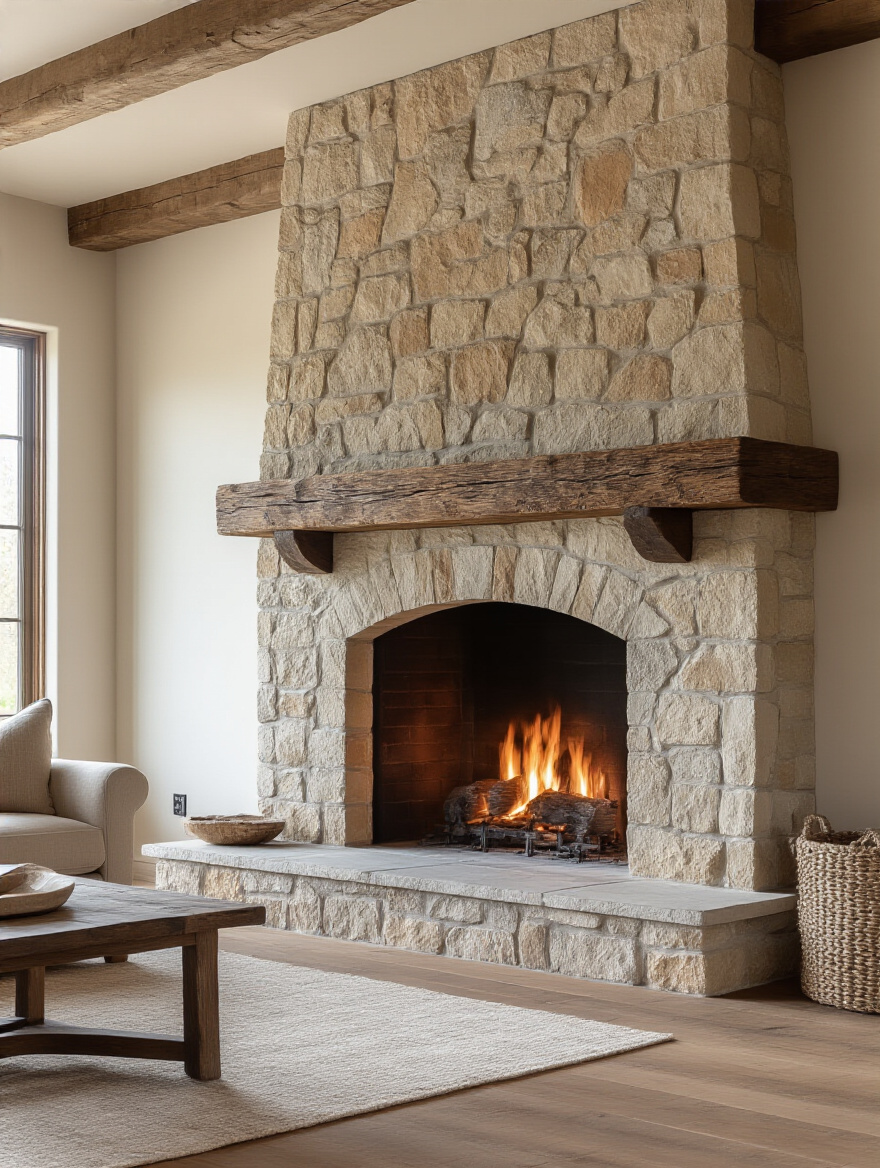
“A well-designed fireplace does more than heat a room; it provides a visual anchor that the rest of the space can orbit around.”
I worked on a project where we replaced a dated tile fireplace with a reclaimed brick surround. It completely changed the room’s center of gravity. Suddenly, everyone wanted to gather there. It became the natural focal point. Invest in this feature. It pays emotional and aesthetic dividends that few other elements can match.
Furnishing with Comfort and Authenticity: Key Pieces and Textures (Part 1)
Now that our main anchors are in place, we can start layering in the other key furnishings. The goal here is to choose pieces that are not only comfortable and functional but also add to the room’s story. Every item should feel like it has a purpose and a history, real or imagined.
7. Opt for Distressed Leather or Plush Upholstered Armchairs and Ottomans
Your oversized sofa needs supporting characters, and this is where comfortable armchairs and ottomans come in. A distressed leather club chair is a classic for a reason—it brings in a rugged, timeless texture and feels like it’s been part of the family for years. The scuffs and creases it collects over time aren’t damage; they’re character.
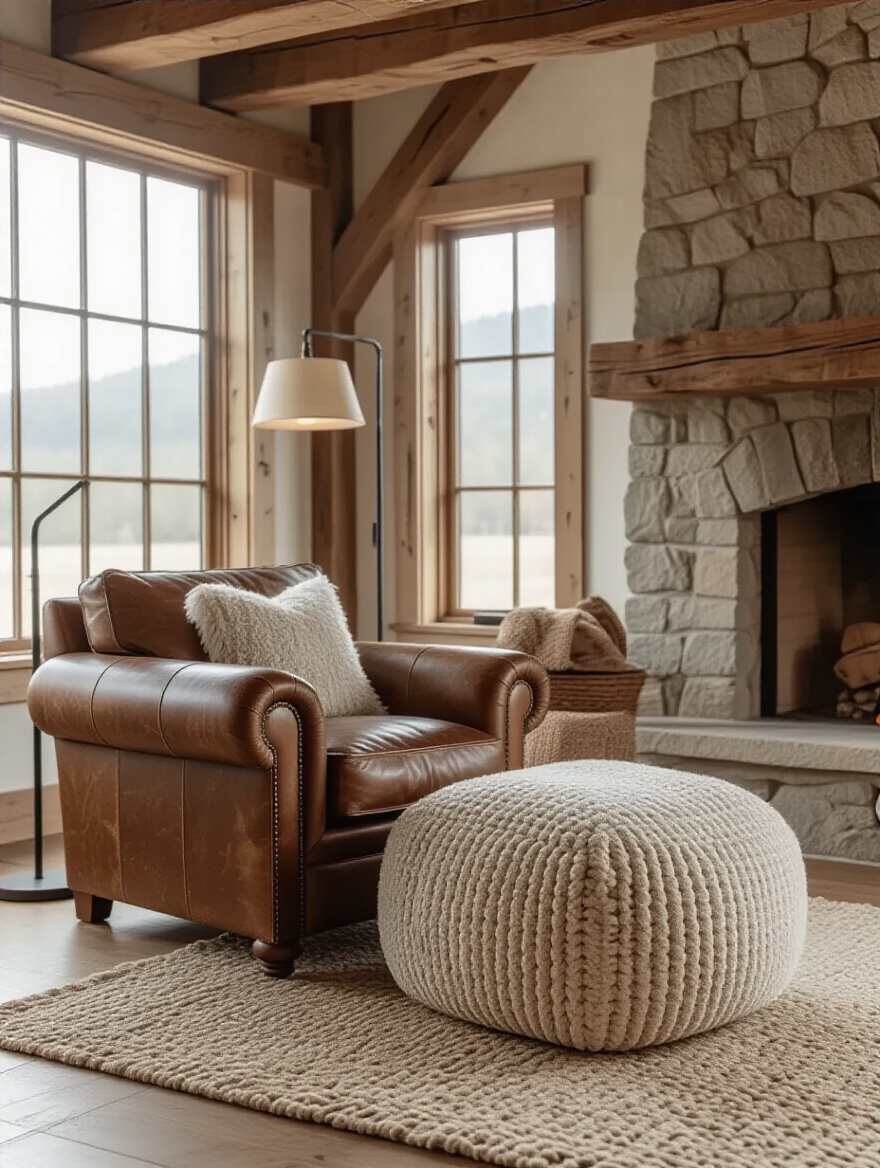
If leather isn’t your thing, go for something deeply plush and upholstered in a natural fiber like wool, bouclé, or thick linen. The key is tactile comfort. You want chairs that invite you to sink in. These secondary seating pieces create cozier, more intimate conversation zones within the larger room, making the space more functional for both big gatherings and quiet moments.
With the main seating in place, it’s time to add the soft layers that scream “cozy.”
8. Introduce Chunky Knit Throws and Faux Fur Rugs for Layered Coziness
This is the easiest, most effective shortcut to making a room feel instantly more inviting. A room full of hard surfaces (wood, stone, leather) needs a counterbalance of extreme softness. Chunky knit throws and faux fur blankets or rugs are a non-negotiable part of the rustic system. Drape them over the arm of a chair, fold them at the foot of the sofa, or layer a sheepskin rug over your main area rug.
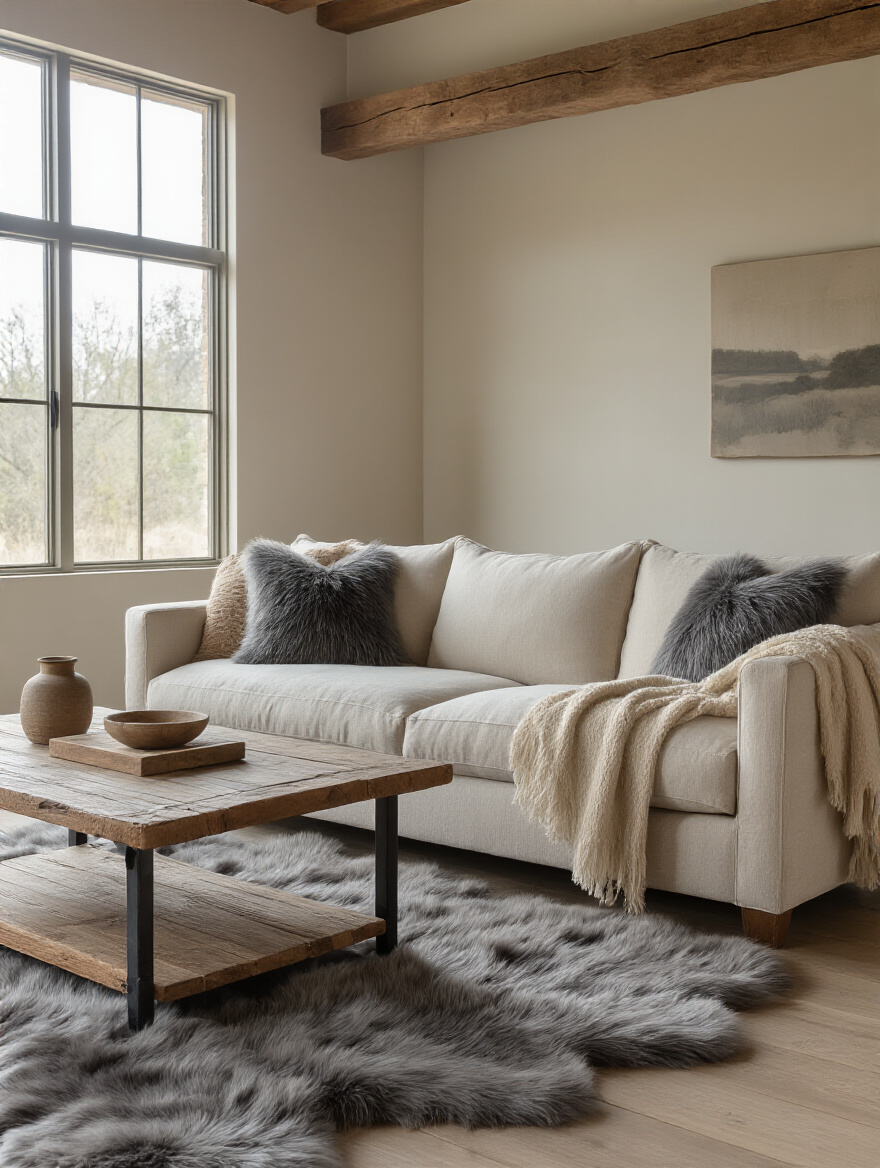
This isn’t just for looks; it’s a sensory experience. These textures invite touch and signal to your brain that this is a place for relaxation. I always tell my clients to think in layers. Your room shouldn’t be a single, flat image. It should have depth, and these soft textiles are the most direct way to create that tactile depth.
Now that we’ve got the soft elements, we need the solid, functional surfaces to balance them out.
9. Select Rustic Coffee and End Tables with Rough-Hewn Details
Avoid matching sets of shiny, mass-produced tables at all costs. What you’re looking for here are pieces that feel substantial and celebrate the raw beauty of wood. A great rustic coffee table should have some heft to it—maybe it’s a single thick slab of wood with a live edge, or a heavy piece made from reclaimed beams that still shows the old saw marks.

These tables serve a critical function: they anchor the seating area and provide a landing spot for drinks, books, and feet. Their imperfections are their greatest strength. They add a layer of authenticity that you just can’t get from something perfectly sanded and lacquered. Look for pieces that feel solid, grounded, and unapologetically themselves.
Once the core furniture is in, we need to address the most important system of all for an organized home: storage.
10. Showcase Handcrafted Wooden Cabinets or Open Bookcases for Storage
Great storage isn’t about hiding things; it’s about creating a system that’s both beautiful and functional. A handcrafted wooden cabinet or a sturdy open bookcase serves as both. It provides an essential function—getting clutter off the floor and surfaces—while also acting as a major design element that reinforces the rustic theme.

I love using a combination of open and closed storage. The open shelves are perfect for displaying curated collections—old books, interesting pottery, family photos—while the closed cabinets can hide the less sightly necessities like board games, cables, and extra electronics. Choose pieces made from solid wood with visible joinery or charming imperfections. This is where you prove that an organized space can also be a warm and soulful one.
Furnishing with Comfort and Authenticity: Key Pieces and Textures (Part 2)
We’re in the home stretch of furnishing. This is where we focus on the smaller details that make the whole system click. These are the elements that elevate a room from “nicely decorated” to “thoughtfully designed.”
11. Integrate Forged Iron or Bronze Hardware and Decorative Fixtures
Pay attention to the little things. The hardware on your cabinets, the curtain rods, the fireplace tools—these are all opportunities to reinforce the rustic aesthetic. Swapping out cheap, generic hardware for something with weight and character, like hand-forged iron or oil-rubbed bronze, makes a world of difference.
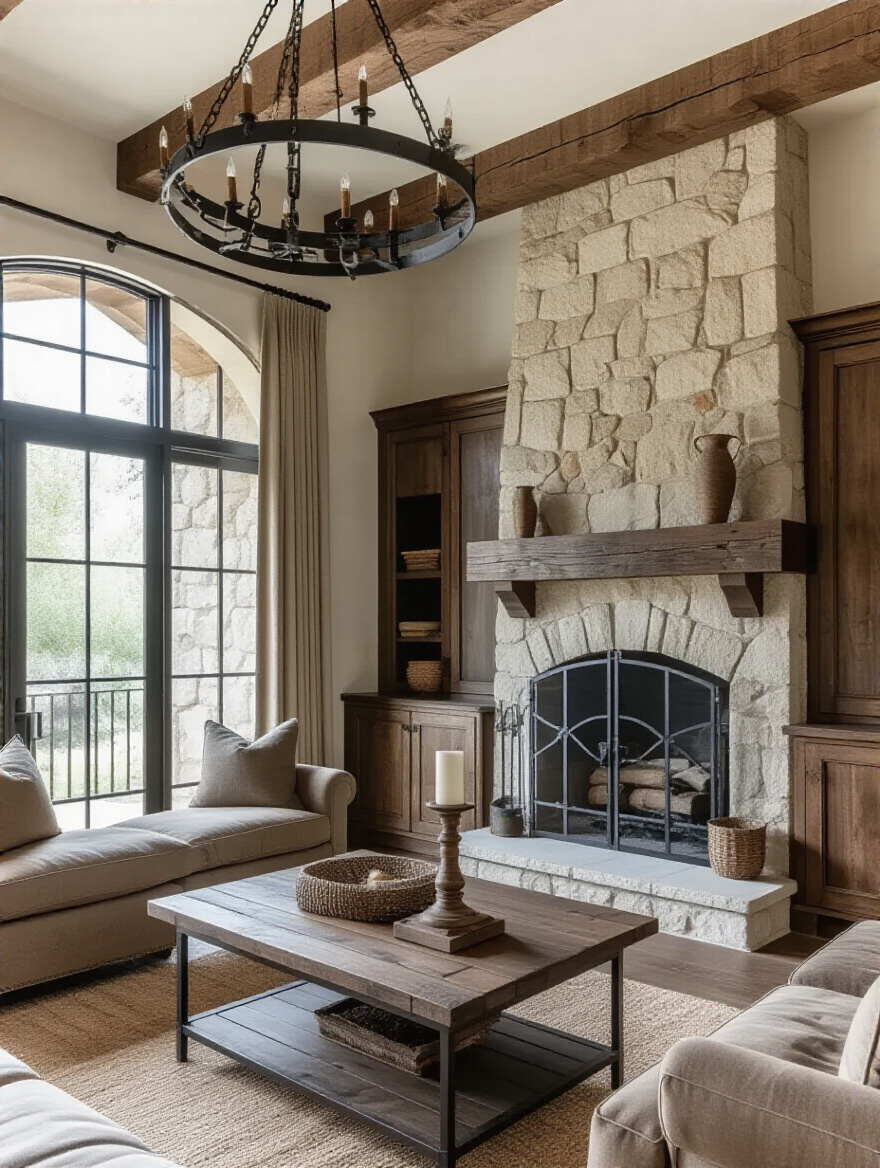
These metals provide a cool, earthy contrast to the warmth of the wood. They feel solid and reliable in your hand, connecting you to a tradition of craftsmanship. It’s a small detail, but it’s a tactile one you’ll interact with every day. It sends a subconscious signal of quality and permanence that permeates the entire room.
Speaking of practical details, let’s talk about one of my favorite organizing tools that happens to be perfect for this style.
12. Add Woven Baskets and Trunk-Style Chests for Stylish Storage Solutions
Woven baskets and old trunks are the secret weapons of a rustic-yet-organized home. They are the perfect solution for “quick-grab” clutter—throw blankets, kids’ toys, magazines, remote controls. Instead of letting that stuff pile up, you can give it a beautiful, textured home. A large wicker basket next to the sofa or a vintage trunk that doubles as a coffee table provides incredible storage capacity while adding another layer of natural texture.

From an organizer’s perspective, this is what I call “beautiful containment.” You’re not just tidying up; you’re creating an intentional system that’s easy to maintain because it looks so good. It’s the perfect blend of form and function, and it’s essential for keeping a family living room feeling serene instead of chaotic.
Illuminating and Accentuating Rustic Style: Decor, Lighting & Personal Touches (Part 1)
The room is built and furnished. Now, we bring it to life. This is the stage where we layer in light, art, and personality. Without these elements, even the most well-designed space can feel like a showroom. This is how you make it yours.
13. Install Warm-Toned Lighting with Edison Bulbs or Industrial Lanterns
Lighting is everything. You could do everything else right, but if you blast your room with harsh, cool-toned overhead light, you’ll kill the vibe instantly. The goal is to create pools of warm, golden light that mimic candlelight or a crackling fire. Edison-style bulbs with their visible filaments are perfect for this, as are fixtures that look like old industrial or barn lanterns.
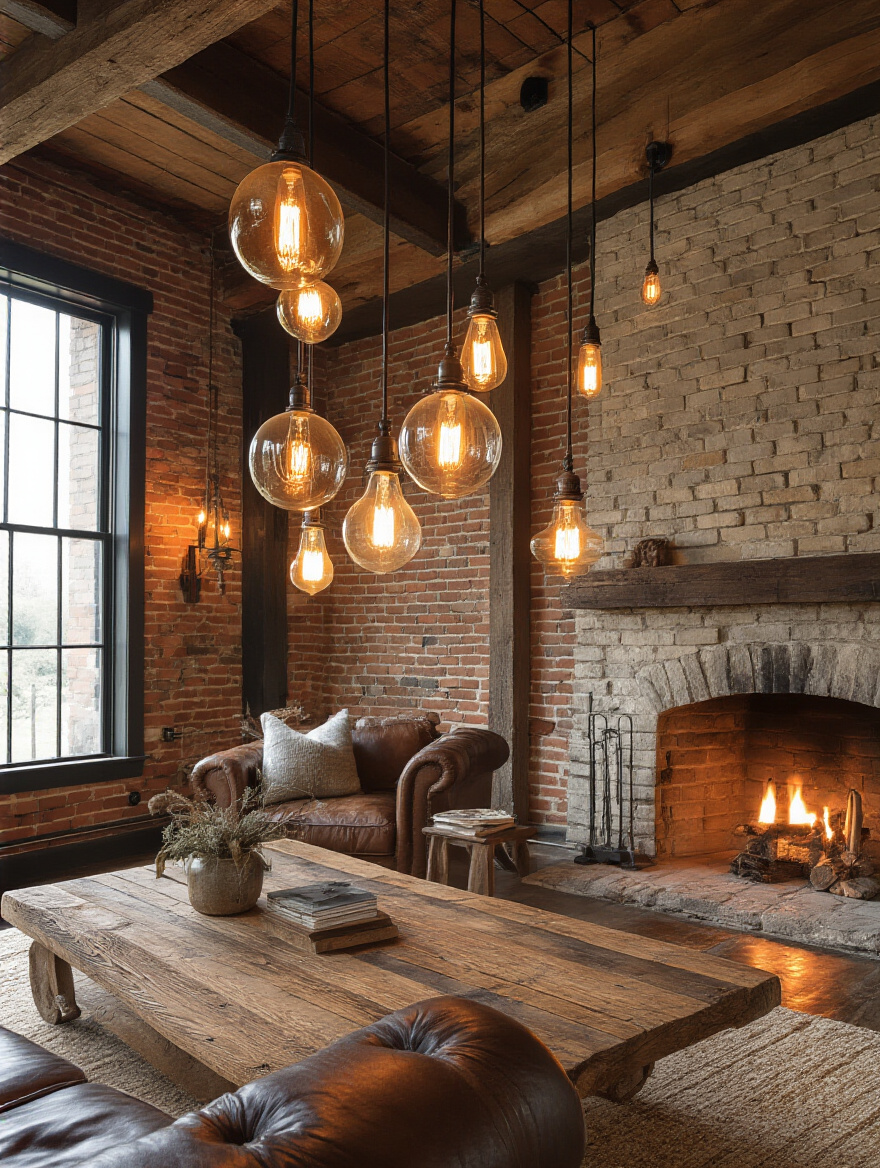
Layer your lighting! You need a mix of ambient (general), task (for reading), and accent (to highlight art or textures) lighting. And put everything on a dimmer. Being able to control the intensity of the light allows you to completely transform the mood of the room at a moment’s notice. Warm, layered, dimmable light is the single most important factor in creating a cozy atmosphere.
Now that the room is beautifully lit, let’s give those lights something interesting to shine on.
14. Display Nature-Inspired Artwork and Vintage Photographs for Wall Decor
Empty walls are a crime. Art is what gives a room its personality and soul. For a rustic space, lean into artwork that connects you to the outdoors. This could be landscape paintings, botanical prints, or even beautifully framed maps of a favorite national park. Mix these with vintage photographs—sepia-toned pictures of ancestors or just interesting old portraits you find at a flea market.
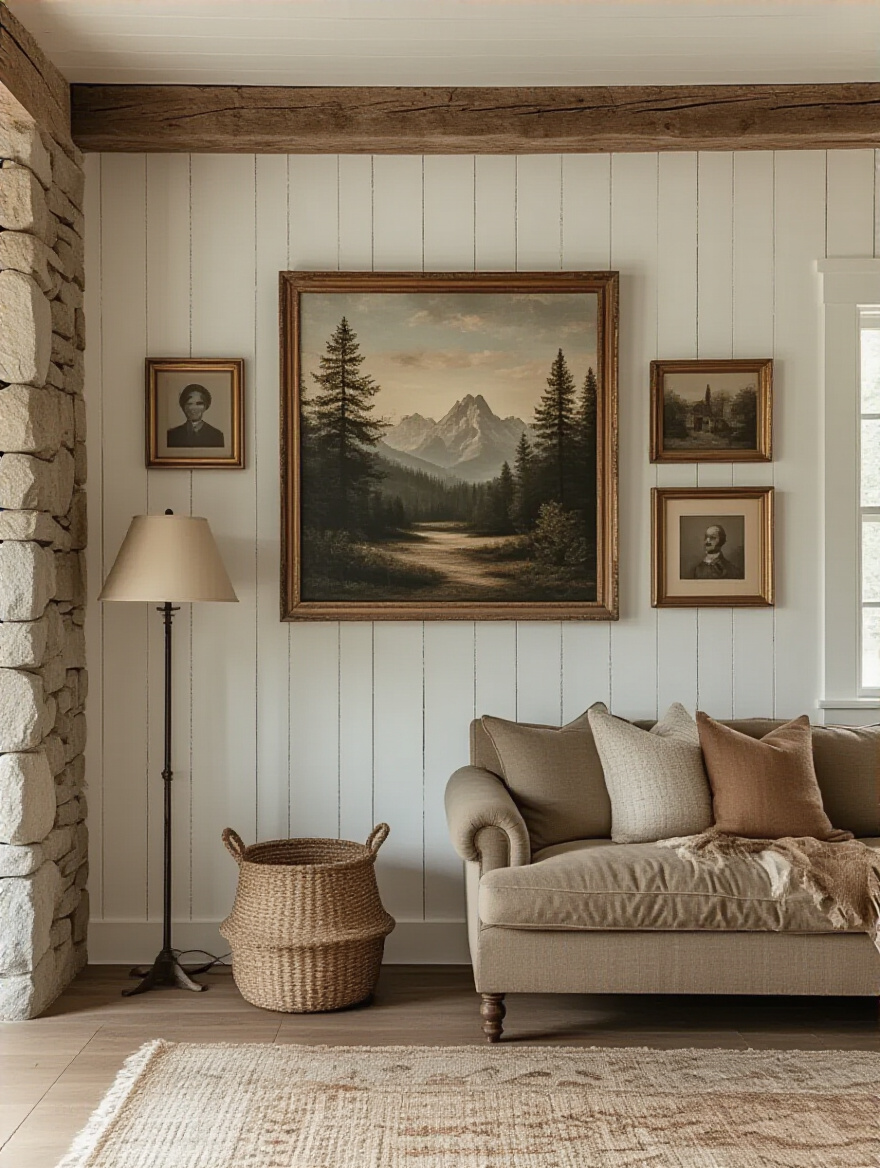
Frame everything in materials that fit the aesthetic, like reclaimed wood or simple matte black metal. Create a gallery wall to tell a bigger story, or let one massive landscape piece serve as a dramatic focal point. The goal is to fill your walls with images that have meaning and reinforce that feeling of history and nature.
Art connects us to nature visually, but we can also bring in the real thing.
15. Bring in Greenery with Potted Plants or Dried Floral and Branch Arrangements
Every room, especially a rustic one filled with wood and stone, needs living things to make it feel vibrant. Plants are the perfect way to add a splash of life and organic texture. A large fiddle leaf fig in a corner, a collection of smaller succulents on a shelf, or a simple vase of eucalyptus or pampas grass can make a huge difference.
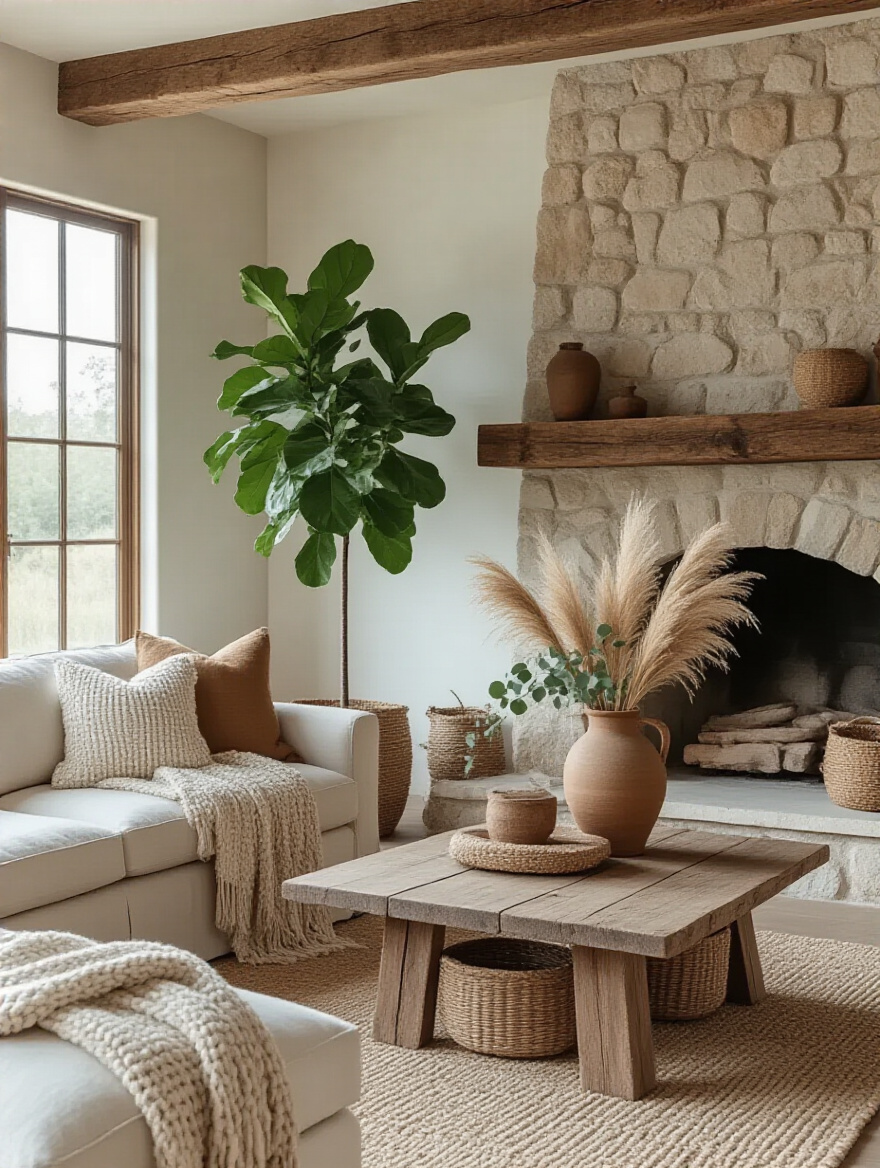
Choose planters that fit the vibe: terracotta, woven baskets, distressed ceramic, or galvanized metal. And don’t forget about dried arrangements! A tall vase filled with dramatic branches or dried florals can provide lasting natural beauty without any of the maintenance. This is the final step in truly blurring the line between indoors and out.
Last but not least in this section, we need to add one final layer of texture that grounds the entire room.
16. Layer Area Rugs with Organic Textures and Earthy Patterns
Even if you have beautiful hardwood floors, an area rug is essential for defining the seating area and adding a crucial layer of softness and warmth underfoot. In a rustic setting, natural fibers are your best friends. Think jute, sisal, wool, or even hide rugs. These materials add a ton of texture and feel great to walk on.
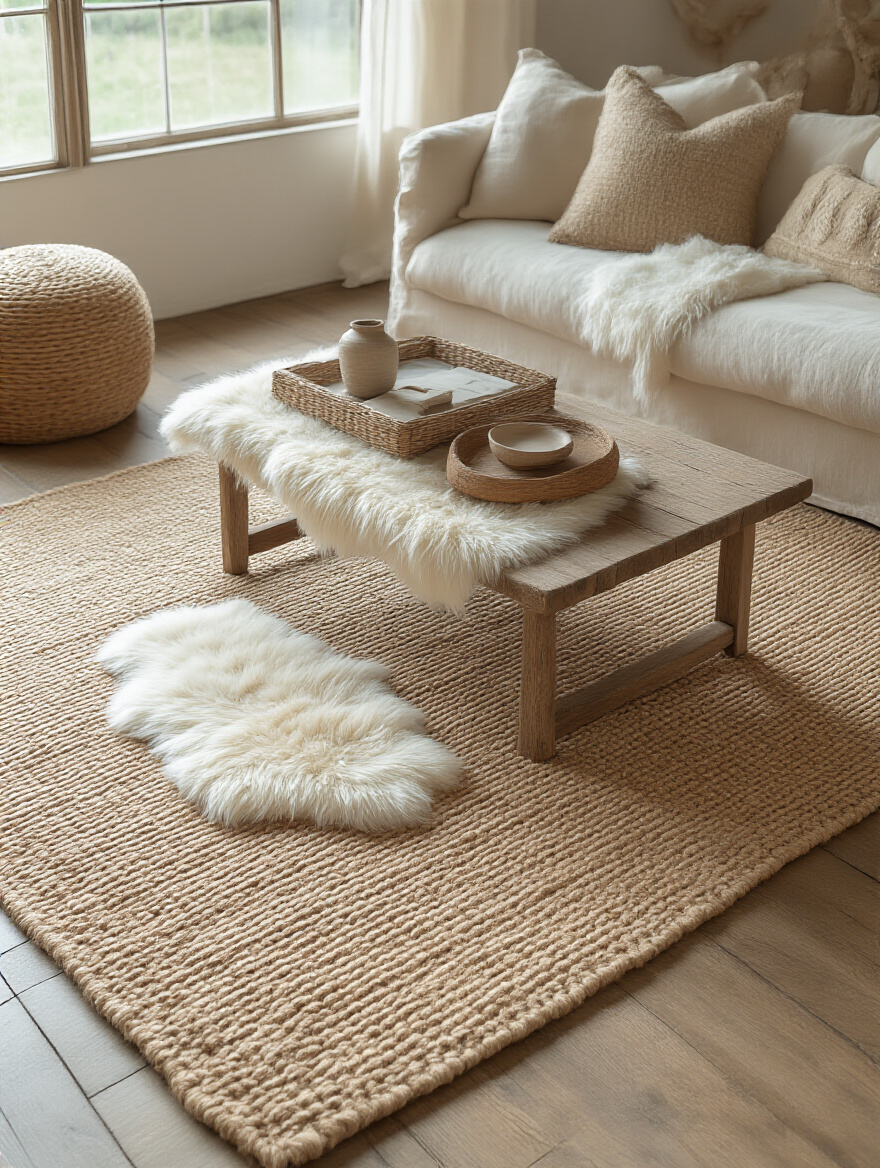
And here’s a pro tip: layer them. Start with a large, neutral rug made of something durable like jute that covers most of the seating area. Then, layer a smaller, plusher rug on top—like a sheepskin or a vintage patterned wool rug—often placed under the coffee table. This technique adds incredible visual depth and makes the space feel extra cozy and curated.
Illuminating and Accentuating Rustic Style: Decor, Lighting & Personal Touches (Part 2)
We’ve reached the final, and most personal, stage. These are the touches that ensure your room doesn’t look like a page from a catalog. This is where your story, your tastes, and your history get woven into the fabric of the space.
17. Curate Found Objects, Antiques, and Hand-Carved Items for Unique Character
This is what truly separates a soulful home from a decorated house. Intersperse your new items with things that have a story. This could be a collection of old bottles you found, a hand-carved wooden bowl from your travels, a set of antique books from your grandparents, or a weathered oar you found at a flea market.
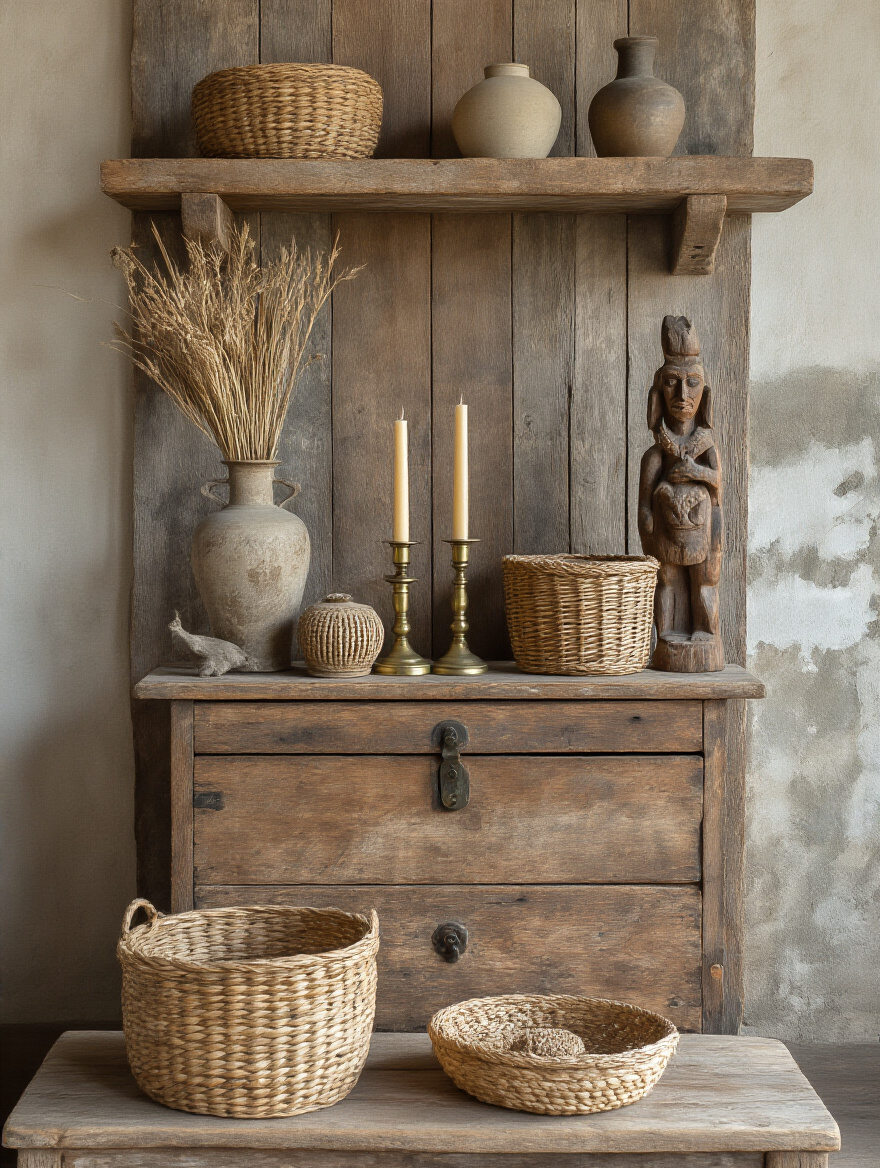
These objects are your personality made visible. They provide moments of discovery and intrigue. Don’t be afraid to display things that are a little imperfect or weird. It’s the history and the sense of a life lived that gives a rustic space its genuine charm. Cluster these items in small groups, or vignettes, on shelves and tables to create focal points.
Finally, let’s create one last functional zone that’s all about hospitality and connection.
18. Consider a Rustic Bar Cart or Drink Station Crafted from Reclaimed Materials
Even if you’re not a big drinker, having a dedicated station for beverages is a wonderful touch for entertaining. It creates a natural gathering spot. A bar cart made from reclaimed wood and industrial pipe, or a small cabinet repurposed as a coffee and tea station, can be a fantastic functional and aesthetic addition.
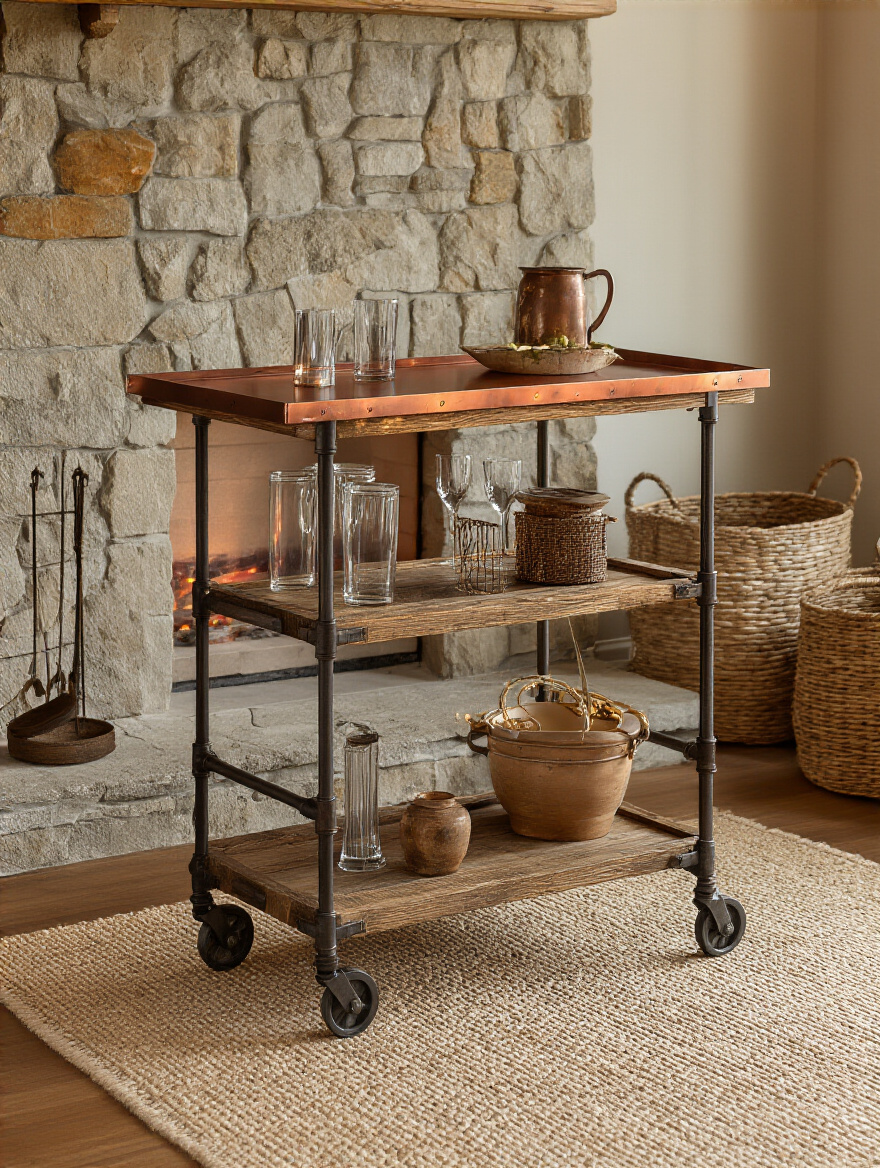
This piece becomes another opportunity to showcase unique materials and a bit of craftsmanship. Style it with interesting glassware, a wooden cutting board, and a small plant. It’s a very practical system that also says, “welcome, make yourself at home.” It’s the final, perfect expression of the warm, inviting, and deeply personal spirit of rustic design.
Conclusion
See? It’s not about just buying “rustic stuff.” It’s about a systematic approach. You build the foundation, you set your anchors, you layer in texture and function, and you finish with light and personality. By following these steps, you’re not just decorating; you’re crafting an environment—a cohesive system designed for comfort, beauty, and real life. You’re creating a space that doesn’t just look rustic but feels like a genuine, soul-soothing retreat from the chaos of the outside world. And there’s nothing more satisfying than that.
